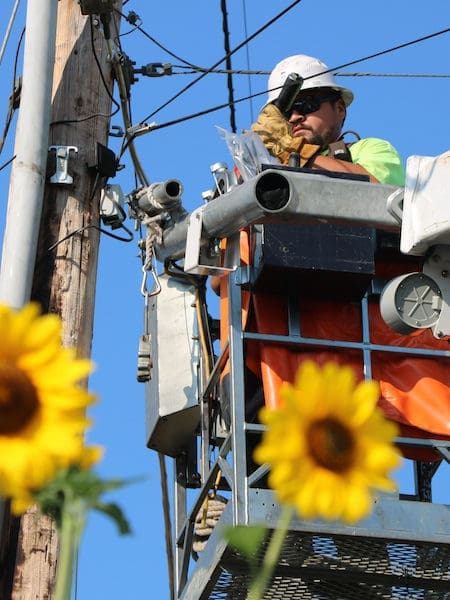Almost all areas already have existing telecommunications infrastructure, but many neighborhoods and cities aren’t yet completely built out with fiber-optic technology. Providers like Hunter Communications are working to construct new networks throughout the country. Constructing a fiber network in a new area is a complex, multi-step process. This article explains how Hunter decides where to expand our network and how we construct a new fiber network in those areas.
Almost all areas of the United States have existing telecommunications infrastructure, but many neighborhoods and cities still lack complete fiber-optic technology. Providers like Hunter Communications are diligently working to build new networks across the country. Constructing a fiber-optic network is a complex, multi-step process. Our team at Hunter Communications compiled this information to explain how we select areas for network expansion and the steps involved in constructing a new fiber network in those regions.
Expansion Planning
Before construction begins, our teams identify cities or neighborhoods for potential expansion. Several factors influence our decision on where to bring our network, including:
Area Interest and Demand: We gather interest information on our website to identify areas where residents and businesses desire Hunter’s fiber-optic internet.
Existing Infrastructure: Our GIS and engineering teams evaluate the presence of existing infrastructure in the area. Hunter serves many governments, schools, and hospitals throughout the state, known as “anchor institutions,” which facilitate the later deployment of residential fiber internet. We also assess existing infrastructure, such as utility poles, from other providers.
Number of Passings: Our teams consider the number of homes and businesses that can be served in a specific area. Hunter aims to deliver fiber-optic internet to as many people as quickly as possible.
Network Design
Once we determine the areas for expansion, our GIS and engineering teams begin designing the new fiber-optic network. This process includes gathering data on existing infrastructure and applying for necessary permits. During this phase, we also locate underground utilities and understand easement and right-of-way access.
Data Gathering
Our Geographic Information Systems (GIS) team collects data on geology, roads, building locations, and poles throughout the area. During this time, our teams map out existing utilities like power, water, and sewer lines.
In addition to analyzing GIS data, our team visits the area to evaluate existing utility poles, walking along pole lines throughout neighborhoods to assess their condition.
Network Design
The engineering team creates detailed plans for the new network using the mapping and pole-walking information. They map out where we can build based on existing infrastructure, including poles and underground utility lines. This planning process can be complex due to factors like permitting, challenging terrain, or railroads. Much of the design phase involves coordinating with local governments, utility companies, and other internet service providers.
When designing a network in a new area, our teams also determine the cabling pathways throughout the neighborhoods and back to our point of presence (PoP), which connects residents to the broader internet. This is also when our teams decide on the construction method—whether aerial or underground.
Aerial construction may involve installing new poles, acquiring permission to use existing poles, and implementing pole improvements to prepare for installation (known as the make-ready process.) Aerial installation can be faster and more cost-effective.
The Underground installation for constructing a fiber network presents its own challenges. For example, some soil types can be difficult or impossible to work with. While underground installation may be more aesthetically pleasing, it is often more expensive.
Permitting and Easements
During the design phase, our teams begin applying for permits. The duration for obtaining permits can vary; some are issued quickly, while others may take up to six months.
If the new network requires access to poles or fiber lines on private property, we must also obtain permission from the individual landowners unless there is an existing utility easement on the property.
Construction
Once our plans are finalized, the engineers pass the job along to our construction team. The duration of construction depends on several factors, including:
- Permitting
- Existing conduit and utility poles
- Terrain
- Construction type
- Weather conditions
During construction, our crews follow the engineering plans and lay miles of fiber-optic cables throughout the area. In some instances, they may also need to install new poles.
Splicing
After construction is complete, our splicing teams begin their work. Splicing is necessary for two reasons: 1) to join cables for long runs and 2) to terminate fiber into transmission equipment. The fiber is fusion spliced together using a machine, then placed into a splicing tray and stored in an enclosure or cabinet. After splicing, our teams test the network to ensure that light levels are optimal and that each splice and fiber cable functions correctly. Once testing and provisioning are complete, service becomes available, and we notify those who have previously expressed interest. Residents can then schedule an installation to bring the fiber directly to their homes.
Are you ready to make the switch to Hunter Fiber?
As we work on constructing a fiber network near you, we hope you’re excited to add adopt this technology in your home or business. Fiber-optic network internet speeds are as much as twenty times faster than cable internet and eighty times faster than DSL. With faster speed, greater bandwidth, and more reliability, every household and business will enjoy the benefits of fiber-optic internet. With Hunter Communications, you can stay connected with the world, enjoy the conveniences of streaming services, and live a more convenient life.

